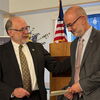UMaine graduate 'finds his star' through the college's innovation engineering program
Matthew Hodgkin, an animal and veterinary sciences graduate, has a lot more than a new Bachelor of Science diploma to show for his four years at the University of Maine in Orono.
He's the co-owner of a lobster-related business exploring ways to create products from lobster-processing waste. A research project he led this year shows early promise as a non-invasive way of testing the viability of lobsters for shipping. And a project he's working on to commercialize currently unmarketable green crabs, if successful, could create demand for an invasive species that's decimating soft-shell clam populations on Maine's coast.
At the heart of those accomplishments is the wild card of any young person's college experience: Finding a mentor.
In Hodgkin's case, the more experienced guide is professor Bob Bayer, executive director of the Lobster Institute, who helped Hodgkin pivot when his original career goal of becoming a veterinarian hit the roadblock of organic chemistry during his sophomore year.
“We started working together because of a dog,” Bayer says, sitting at a small table in a campus office with Hodgkin, who graduated from UMaine on May 9. “A nice yellow lab,” Hodgkin adds. “We would just chat after class. He asked me to do some research for the Lobster Institute and it evolved into a mentoring relationship … If you look for those paths on your own, you don't always find them. Bob helped me to see some of the possibilities.”
“I just made the suggestion, 'Innovation engineering — check it out,'” Bayer recalls.
Hodgkin did and graduated with a minor in innovation engineering, a multi-disciplinary program that teaches students from any major “to create, communicate and commercialize, or otherwise realize, meaningfully unique ideas in any field.”
Given that emphasis, it's not surprising that Hodgkin's capstone project advances the Lobster Institute's early efforts, dating back to the late 1970s, to measure the viability of Maine lobsters prior to shipping. Given the whopping 45.4% increase in the export value of Maine lobsters between 2013 and 2014 — accounting for almost $366 million of last year's seafood exports — that's hardly an academic question. Air transportation to China and South Korea, where demand for Maine lobsters is skyrocketing, can take up to 60 hours — long enough to stress and kill the weakest lobsters.
Real-life problems
To demonstrate how the lobster claw strength sensor works, Hodgkin picks up a good-sized lobster and carefully removes a thick rubber-band from the crustacean's crusher claw. He picks up a syringe needle and carefully inserts the needle into a gap between sections of the lobster's tail, drawing out a small sample of clear liquid called hemolymph (the equivalent of blood in arthropods). He withdraws the syringe and squirts the liquid onto a reflector plate of a refractometer.
The device provides a reading of the lobster's serum protein: 9.6. The higher the level, the greater the muscle mass and the more viable that lobster is for shipping long distances. Both Bayer and Hodgkin agree: This lobster is ready for a one-way trip to China.
“We actually developed this in the late '70s,” Bayer says. “A graduate student and I came up with the procedure. It's relatively quick and easy. If you take random samples from lobsters that were caught in a given area, they tend to be the same molt size and their serum levels are similar. The higher the protein, the farther you can ship them.”
The drawback of that testing procedure is that it's invasive and requires careful attention to avoid an errant needle jab.
Bayer says Hodgkin's project to find an alternative procedure grew out of earlier work done by Thomas McKay, a UMaine mechanical engineering technology student, and his professor, Michael “Mick” Peterson. In response to an inquiry about the strength of lobster claws, Bayer sought the help of Peterson and his student, who created a simple device using a load cell meter to measure the closing strength of lobster claws. Their first device was made out of hard plastic. The lobsters made short work of it.
Following the “fail fast, fail cheap and move on” principle, Peterson and McKay took their design and made a new one out of metal. It delivered reliable measurements of the claw strength of numerous lobsters. Bayer then wondered if the device might be used as a non-invasive alternative for evaluating the viability of lobsters for shipping and suggested to Hodgkin that he take it on as a project.
Hodgkin says he followed the four-step process he'd learned in the innovation engineering program: Discover, define, develop and deliver. The first step was to discover if there was, indeed, a correlation between the serum protein samples using the invasive technique and the claw strength measurements using the lode cell metering device. He tested lobsters of similar sizes and from different stages of their molt cycle. Then he compared the results of the two methods.
The results, Hodgkin says, are promising — showing that there is a relationship between serum protein and muscle strength as measured by the claw strength sensor. The next steps, he says, will be to expand the sampling of lobsters seasonally and geographically in order to validate the alternative non-invasive way of measuring viability.
One problem he's already identified with the prototype sensor is that it appears to be less sensitive in measuring the grip strength of lobsters coming from water on the colder end of the spectrum, chiefly because those lobsters tend to be “less interested in squeezing” the sensor. “I have another mentor in Connecticut who has advised me, 'Always drill down into your ideas and data; look into them more deeply,'” Hodgkin says.
“I'm going to stick with it and keep on working on the project,” he adds. The funding has come from the Center for Undergraduate Research and the Lobster Institute.
Real-life opportunities
The oldest of three children, Hodgkin grew up in Colebrook, Conn., which he jokingly refers to as “the icebox of Connecticut,” a good preparation for living in Maine. His father is a computer programmer and his mother is a nurse. He acknowledges that sometimes he forgets to tell his family about new projects.
What he's learned from his work with Bayer at the Lobster Institute, he says, is the value of seeking answers to real-life problems. From the innovation engineering program, he's learning how to transform those answers into products with real-world market potential.
That's the impetus for a project he's still working on with Jason Bolton, an assistant professor in UMaine's food science and human nutrition program: Making sausages out of the meat of green crabs. In recent years, green crabs have become a major problem along the entire coast due to their exploding population and their heavy predation of soft shell clams and blue mussels. That's a big problem, since clams and mussels together were a $21.2 million fishery in 2014, according to the Department of Marine Resources.
The obvious solution of harvesting those pesky green crabs to keep their populations in check comes up against the problem that there isn't a clear market demand for them, as food, as bait, or for some other use. Every problem is a potential market opportunity, and Hodgkin figures creating food out of those crabs might offer the most promise. On the four-part innovation checklist: Check and check for “discover” and “define.”
The development stage has led to numerous experiments of how to extract the crab meat from the shells mechanically, since it's too labor-intensive and costly to do it by hand. And then, once you have the meat, the challenge becomes finding the right mix of ingredients to make a tasty food with a decent texture. Hodgkin says they're not at the stage of delivering a commercial product yet, and he acknowledges even if they get there, the “consumer problem” looms of getting people to redefine their notion of “sausage.”
With Bayer, Lobster Institute Associate Director Cathy Billings and Stewart Hardison, an entrepreneur from outside the UMaine community, Hodgkin also has created Lobster Unlimited LLC (formerly LobsteRx), a company seeking to find new uses for lobster-processing waste and whose motto is “We throw away nothing.” One potential use involves turning the shells from millions of processed lobsters into organic fertilizer for golf courses.
“It's been fun, it's always exciting and once you reach those milestones where your idea is getting closer and closer to fruition, it's very exciting,” says Hodgkin, who's looking into graduate programs to continue his studies.
“These are all real-world problems that need solutions,” adds Bayer. “There are so many questions out there.”















Comments